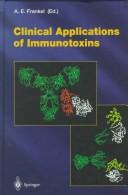| Listing 1 - 4 of 4 |
Sort by
|
Periodical
ISSN: 15571890 Publisher: Place of publication unknown
Abstract | Keywords | Export | Availability | Bookmark
 Loading...
Loading...Choose an application
- Reference Manager
- EndNote
- RefWorks (Direct export to RefWorks)
Neuropathology --- Pharmacology. Therapy --- Immunopharmacology --- Neuroimmunology --- Immunopharmacologie --- Neuro-immunologie --- Periodicals. --- Périodiques --- Neuropharmacology. --- Allergy and Immunology. --- Immunopharmacology. --- Neuroimmunology. --- Neuro-immunologie. --- Immunopharmacologie. --- Health Sciences --- Immunology --- Pharmacy and Pharmacology --- farmacologie
Periodical
Abstract | Keywords | Export | Availability | Bookmark
 Loading...
Loading...Choose an application
- Reference Manager
- EndNote
- RefWorks (Direct export to RefWorks)
Allergy and Immunology --- Pharmacology --- Immunopharmacology --- Immunopharmacologie --- periodicals --- Periodicals --- Periodicals. --- Périodiques --- Périodiques --- MDPHARMA MDALLERG --- periodicals.
Periodical
Abstract | Keywords | Export | Availability | Bookmark
 Loading...
Loading...Choose an application
- Reference Manager
- EndNote
- RefWorks (Direct export to RefWorks)
"International Immunopharmacology is the primary vehicle for the publication of original research papers pertinent to the overlapping areas of immunology, pharmacology, cytokine biology, immunotherapy, immunopathology and immunotoxicology."
Immunology. Immunopathology --- Pharmacology. Therapy --- Pharmacology --- Allergy and Immunology --- Immunopharmacology --- Cytokines --- Immunology --- Immunopharmacologie --- Immunologie --- Periodicals --- Périodiques --- Immunotherapy --- Biological response modifiers --- Allergy and Immunology. --- Pharmacology. --- Immunity --- Immunotherapy. --- Cytokines. --- Biological response modifiers. --- Immunopharmacology. --- drug effects. --- Immunotherapies --- Immunity, Active --- Immunologic Techniques --- Pharmacologies --- Pharmaceutical Preparations --- Allergy Specialty --- Allergy, Immunology --- Immunology and Allergy --- Immunology, Allergy --- Specialty, Allergy --- pharmacology --- Chemistry --- Health Sciences --- Life Sciences --- Toxicology --- General and Others --- Pharmacy and Pharmacology --- Cytology, Cell Biology --- farmacologie --- Cytokine --- drug effects --- Combined Antibody Therapeutics

ISBN: 3540640975 3642721559 3642721532 Year: 1998 Volume: 234 Publisher: Berlin ; Heidelberg ; New York Springer Verlag
Abstract | Keywords | Export | Availability | Bookmark
 Loading...
Loading...Choose an application
- Reference Manager
- EndNote
- RefWorks (Direct export to RefWorks)
1 2 D. FITZGERALDI, I. PASTAN , and J. ROBERTUS Introduction . . . . . . . . . . . . . I 2 Toxin Structure-Function Properties 2 2. 1 Functions. . . . . . . . . . . . . . . . . . . . . . . . 2 2. 2 Binding. . . . . . . . . . . . . . . . . . . . . . . . . 3 3 Intracellular Processing - Cleavage and Reduction . . . . . . 4 3. 1 Cytosolic Activity . . . . . . . . . . . . . . . . 5 4 Immunotoxin Design and Testing. 6 5 Conclusion. . 8 References. . . . . 8 1 Introduction While various treatment approaches for cancer include reversal of the transformed phenotype, stimulation of immune responses, inhibition of metastatic spread and deprivation of key nutrients, the goal of immunotoxin treatment is the direct killing of malignant cells. Because they are enzymatic proteins that act catalytically to kill cells, bacterial and plant toxins are often employed as the cell-killing component of immunotoxins. Here we provide background information into the structure-func tion relationships of toxins and discuss how they can be combined with cell-binding antibodies or other ligands to generate immunotoxins. Bacterial and plant toxins (e. g. , diphtheria toxin, Pseudomonas exotoxin and ricin) are among the most toxic substances known. However, because they bind to cell surface receptors that are present on most normal cells, unmodified toxins are generally useless as anti-cancer agents. To convert toxins into more selective agents, their binding domains are either eliminated or disabled and replaceq with cell binding antibodies that are tumor-selective.
Farmacologie [Immuno] --- Immunofarmacologie --- Immunopharmacologie --- Immunopharmacology --- Pharmacoimmunology --- Pharmacologie [Immuno] --- Immunotoxins --- Diphtheria toxin --- Ricin --- therapeutic use --- pharmacology --- therapeutic use. --- pharmacology. --- Therapeutic use. --- Pharmacology. --- Antibody-toxin conjugates --- Therapeutic use --- Immunology. --- Cancer research. --- Hematology. --- Cancer Research. --- Pharmacology/Toxicology. --- Drug effects --- Medical pharmacology --- Medical sciences --- Chemicals --- Chemotherapy --- Drugs --- Pharmacy --- Haematology --- Internal medicine --- Blood --- Cancer research --- Immunobiology --- Life sciences --- Serology --- Physiological effect --- Diseases --- Antibody-toxin conjugates. --- Conjugates, Antibody-toxin --- Immunoconjugates --- Immunoglobulin-toxin conjugates --- Toxin-antibody conjugates --- Toxin-immunoglobulin conjugates --- Bioconjugates --- Immunotoxicology --- Toxins
| Listing 1 - 4 of 4 |
Sort by
|

 Search
Search Feedback
Feedback About UniCat
About UniCat  Help
Help News
News